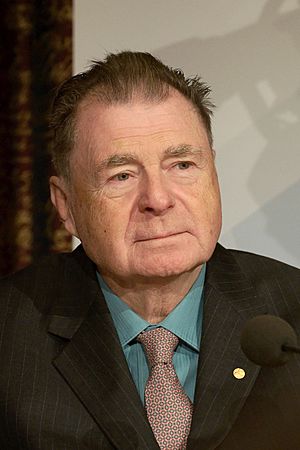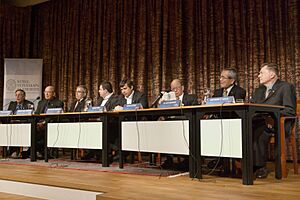Richard F. Heck facts for kids
Quick facts for kids
Richard F. Heck
|
|
|---|---|

Heck in 2010
|
|
| Born |
Richard Frederick Heck
August 15, 1931 Springfield, Massachusetts, U.S.
|
| Died | October 9, 2015 (aged 84) |
| Nationality | American |
| Alma mater | UCLA (BS, PhD) |
| Known for | Heck reaction |
| Spouse(s) | Socorro Nardo-Heck (died 2012) |
| Awards | Glenn T. Seaborg Medal (2011) Nobel Prize in Chemistry (2010) |
| Scientific career | |
| Fields | Chemistry |
| Institutions | University of Delaware Hercules ETH Zurich De La Salle University |
| Doctoral advisor | Saul Winstein |
Richard Frederick Heck (born August 15, 1931 – died October 9, 2015) was an American chemist. He is famous for discovering and developing the Heck reaction. This important chemical reaction uses a metal called palladium to help join different organic molecules together. For example, it can connect aryl halides with alkenes.
The Heck reaction is used to make many useful things. One example is the pain medicine naproxen. Because of his amazing work with palladium in organic synthesis, Richard Heck won the 2010 Nobel Prize in Chemistry. He shared this award with two Japanese chemists, Ei-ichi Negishi and Akira Suzuki.
Contents
Early Life and Education
Richard Heck was born in Springfield, Massachusetts, in 1931. When he was eight years old, his family moved to Los Angeles. He later attended the University of California, Los Angeles (UCLA). There, he earned his first degree in 1952. He then completed his Ph.D. in chemistry in 1954. His research focused on the chemistry of aryl sulfonates, guided by his professor, Saul Winstein.
After finishing his studies at UCLA, Heck did more research in Zürich, Switzerland at the ETH Zurich. He also returned to UCLA for a short time. In 1956, he started working at the Hercules Corporation in Wilmington, Delaware. His first projects there were about making polymers, which are large chain-like molecules.
Developing the Heck Reaction

At Hercules, Richard Heck became very interested in organometallic chemistry. This is a field that studies compounds containing bonds between carbon and a metal. He worked with David S. Breslow on reactions involving organocobalt.
This work led him to develop the Heck reaction. In the late 1960s, he started studying how to join arylmercury compounds with olefins. He found that palladium could act as a catalyst for this process. A catalyst is something that speeds up a chemical reaction without being used up itself. He published his findings in a series of seven articles. He was the only author on all of them.
In the early 1970s, another scientist, Tsutomu Mizoroki, found a similar way to do this reaction. He used less harmful aryl halides instead of arylmercury compounds. In 1971, Heck became a chemistry professor at the University of Delaware. He kept working on and improving the reaction. He made it a very powerful tool for creating new organic molecules.
The importance of the Heck reaction grew as other chemists started using it. By 1982, Heck could describe all known uses of the reaction in just 45 pages. But by 2002, there were so many applications that a chapter on just one type of Heck reaction (intramolecular) needed 377 pages! This shows how widely used and important the reaction had become.
Today, the Heck reaction is one of the most common ways to create carbon-carbon bonds. These bonds are the backbone of all organic chemicals. Many scientific papers and even a whole book have been written about it.
Palladium-Catalyzed Coupling Reactions
Richard Heck's discoveries paved the way for many other important reactions. These are also called palladium-catalyzed coupling reactions. They use palladium to join different types of molecules. Examples include joining aryl halides with boronic acids (Suzuki–Miyaura coupling) or organotin reagents (Stille coupling).
These reactions are now used a lot in making pharmaceutical drugs. For example, they help produce medicines like naproxen.
One of Heck's most important contributions was a reaction that joins an alkyne with an aryl halide. This specific reaction was used to attach glowing dyes to DNA bases. This made it possible to automate DNA sequencing, which helps us study the human genome. It also allows scientists to track important proteins in living things.
Later Life and Recognition
Richard Heck retired from the University of Delaware in 1989. He became a special professor emeritus there. In 2004, the university named its annual chemistry lecture series in his honor. He received several awards for his work. These included the Wallace H. Carothers Award in 2005 and the Herbert C. Brown Award in 2006.
On October 6, 2010, the Swedish Royal Academy of Sciences awarded him the Nobel Prize in Chemistry. He shared it with Ei-ichi Negishi and Akira Suzuki. They were recognized for their work on "palladium-catalyzed cross couplings in organic synthesis." In 2011, Heck also received the Glenn T. Seaborg Medal.
After retiring, Heck moved to Quezon City, Philippines, with his wife, Socorro Nardo-Heck. They did not have children. In 2012, he was appointed as an adjunct professor at De La Salle University in Manila.
Richard Heck passed away on October 9, 2015, in a public hospital in Manila. His wife had passed away two years before him.
Honorary Degrees
Richard Heck received special honorary doctorates from two universities. He received one from the Faculty of Pharmacy at Uppsala University in 2011. The other was from De La Salle University in 2012.
See also
 In Spanish: Richard Heck para niños
In Spanish: Richard Heck para niños

